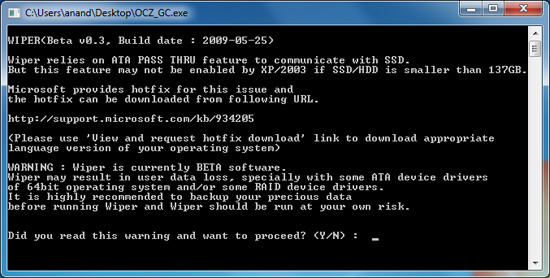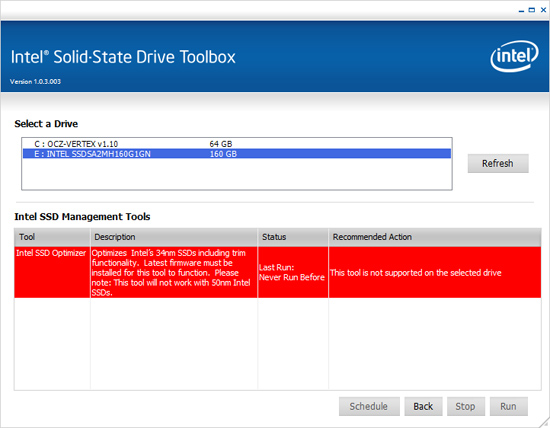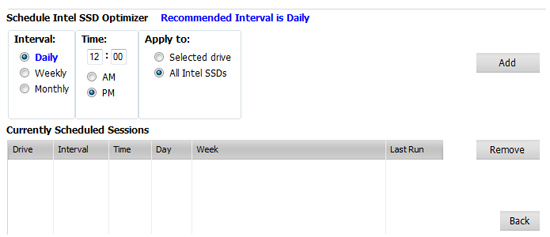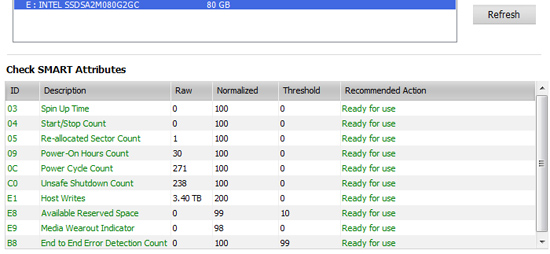The SSD Improv: Intel & Indilinx get TRIM, Kingston Brings Intel Down to $115
by Anand Lal Shimpi on November 17, 2009 7:00 PM EST- Posted in
- Storage
Wipe When You Can’t TRIM
There’s a major problem with TRIM today. The only Windows storage drivers to support it are written by Microsoft. The Intel Matrix Storage Manager (IMSM) driver will not pass the TRIM instruction to your SSD. This means you can't use anything but the drivers that ship with Windows 7. To make matters worse, if you enable non-member RAID on an Intel motherboard the default Windows 7 driver is an older version of IMSM so TRIM won't work there either - even if you don't have a RAID array created. Your best bet is to install Windows 7 with your I/O controller in AHCI mode (for Intel chipsets) and don't install any storage drivers. Intel is working on an updated IMSM that will pass the TRIM instruction to SSDs but it won't be ready for at least a couple of months.
TRIM won't work on a RAID array.
If you want to use IMSM or if you're using Windows XP or Vista, both of which do not support TRIM, there's another option. Earlier this year Indilinx released its Wiper Tool that performs a manual TRIM on their SSDs. It works by asking the OS for a list of the free space addresses on the partition and then sending the list with instructions to TRIM down to the SSD.

The Indilinx Wiper Tool
Today Intel introduces its own manual TRIM tool as a part of the SSD Toolbox:

On any Windows OS (XP, Vista or 7) regardless of what driver you have installed, Intel's SSD Toolbox will allow you to manually TRIM your drive. Intel calls it the SSD Optimizer, which of course only works on 34nm Intel SSDs (X25-M G1 owners are out of luck unfortunately).

The Intel SSD Optimizer lets you schedule the manual TRIM operation automatically
The SSD Toolbox also gives you access to SMART and drive health data, including telling you how many writes you've performed on your SSD, and what your current flash wear level is:

Running Intel's SSD Optimizer does work as advertised. I ran the PCMark HDD suite on a clean X25-M, once more on a drive that had been well used and once more after running the SSD Optimizer:
| PCMark Vantage HDD Score | Clean Run | Used Run | After SSD Optimizer |
| Intel X25-M G2 160GB | 35909 | 30354 | 34014 |
Intel's SSD Optimizer should be able to restore performance to about 95%+ of new, in this case it manages 94.7% - close enough.
Moving On: Forget About Invalid Data and Worry About Free Space
The existence of TRIM changes the way we test, something I alluded to in the SSD Relapse. Thankfully, we come prepared.
In previous articles we had to test SSDs in two conditions: new and used. The new state is just after a secure erase, the used state required us to write data to every user accessible portion of the drive first before benchmarking. The former resulted in great performance, the latter meant the SSD had to do a lot of juggling of existing data whenever it went to write. The second scenario no longer exists with TRIM. The act of formatting your drive or deleting files (and emptying the recycle bin) will TRIM invalid data.
Performance in a TRIM enabled system is now determined not by the number of invalid blocks on your SSD, but rather the amount of free space you have. I went into a deep explanation of the relationship between free space and the performance of some SSDs here.
TRIM will make sure that you don’t have to worry about your drive filling up with invalid data, but it doesn’t skirt the bigger issue: dynamic controllers see their performance improve with more free space.
My rule of thumb is to keep at least 20% free space on your drive, you can get by with less but performance tends to suffer. It doesn’t degrade by the same amount for all drives either. Some controllers are more opportunistic with free space (e.g. Intel), while others don’t seem to rely as much on free space for improved performance. Addressing performance degradation as drives fill up (with valid data) will be one of the next major advancements in SSD technology.










162 Comments
View All Comments
mrt2 - Monday, November 23, 2009 - link
Ok so with all this new data in mind, what's currently the fastest, least performance degrading 256GB SSD you can get for under $1000? I'm currently running Snow Leopard on a dual quad core Mac Pro... I'm not sure Snow Leopard supports any of the new technologies like TRIM or not... but whatever the best 256GB SSD I can get, that's what I'd like....rdhir - Wednesday, November 18, 2009 - link
WARNING on Intel Matrix driversI just wanted to add a word of warning over drivers and SSD. I just built a new i5 750/P55 system with a Corsair X64 drive (Indilinx). While the system worked fine in bits it frequently froze. I tried lots of things to cure it, but in the end the fix was simple. I HAD to use the Intel drivers to avoid intermittent freezing.
Because I had made the SSD the C:drive and used a 1TB Samsung F2 as the D: drive, I had not wanted to lose TRIM support, until the new AHCI drivers came out, but MS drivers don't work. reference article is here http://derek858.blogspot.com/2009/01/windows-7-int...">http://derek858.blogspot.com/2009/01/windows-7-int...
Reading around some of the othere references Its inconsistent and depends on how the drives implements the command set so your mileage may vary but I think its a big issue.
I think we could all do with an article on how best to configure an SSD based system. I decided that I wanted to move "Users" and all associated hidden directories to the D: drive (a 1TB HD) leaving the 64GB for Windows and Apps. This would mean it would never get too full.
I'm amazed at how difficult Microsoft make it to shift the "Users" directory to another drive. In fact they have a Knowledge base article saying not to - Linux easy, just map /home elsewhere.
In the end I followed some instructions to create a junction from C:\Users to D:\Users, but its non-trivial and involves opening a command window in the middle of the installation process.
Yes I'd like to have done it with an autounattend.txt but the MS KB articles says it won't really work.
mapesdhs - Thursday, November 19, 2009 - link
> In the end I followed some instructions to create a junction from
> C:\Users to D:\Users, but its non-trivial and involves opening a
> command window in the middle of the installation process.
I can't see this sort of thing becoming any easier until MS ditches
the archaic idea of drive letters and switches to a more natural
unified file system such as is used with all UNIX OS variants.
(oh look, the pits of hell seem to be getting a tad icey...)
Ian.
MadAd - Thursday, November 19, 2009 - link
"I think we could all do with an article on how best to configure an SSD based system"That would be great
CuriousMike - Monday, November 23, 2009 - link
" "I think we could all do with an article on how best to configure an SSD based system""That would be great " "
Thirded.
The variety of do's and don'ts (and conflictions) are numerous:
-do disable pagefile. don't. oh, which OS?
-don't defrag disk. do. oh, which OS?
-use ram disk for temp files. don't. no, wait, do.
ol1bit - Wednesday, November 18, 2009 - link
I can't believe they don't have firmware for my drive to trim it... I just bought the sucker 3 months ago.....Intel X25-M SSDSA2MH080G1 80GB SATA II MLC Internal Solid state disk (SSD)
dagamer34 - Wednesday, November 18, 2009 - link
No TRIM for G1 drives. Sorry.yacoub - Tuesday, November 17, 2009 - link
An old article reposted as new simply because of a couple-sentence-long update? Interesting.Also, $85? No, try $130 and no MIR. Thanks ScrewEgg!
http://www.newegg.com/Product/Product.aspx?Item=N8...">http://www.newegg.com/Product/Product.a...pk=kings...
7Enigma - Tuesday, November 17, 2009 - link
If the only update was the 2 short blurbs at the top of the first page I don't think this entire article should be reposted. A simple statement with a link to the previous article would be fine. I just wasted a couple minutes going through each page realizing nothing was new....not cool. I was psyched for another SSD article Anand!max22 - Tuesday, November 17, 2009 - link
I installed Intel's pulled firmware fine on my G2 drives. Nothing happen to them at all. I think the whole issue has been blown way over the top.